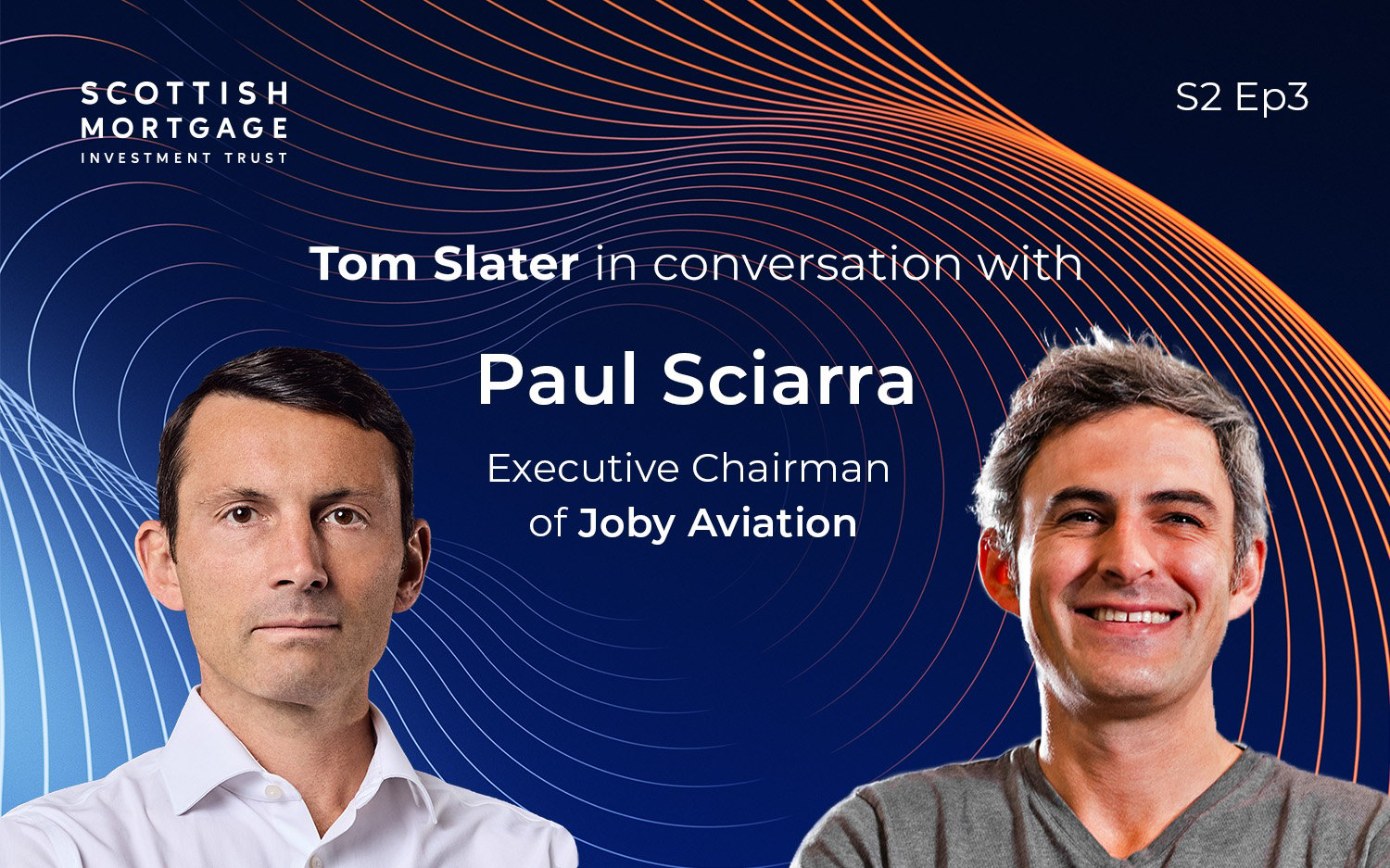December 2023
Article
5 minutes
Joby Aviation: preparing for takeoff
Claire Shaw – Portfolio Director
Key Points
- Urban congestion and the costs of building new ground infrastructure make it difficult to improve the efficiency of existing modes of transport
- In the latest episode of Invest in Progress, Paul Sciarra, Executive Chairman of Joby Aviation, tells Tom Slater how its electric aircraft will provide a quicker, quieter and greener way to travel
- As the company continues to scale production and roll out its operations, it is poised to have a significant impact on the future of urban transportation

As with any investment, your capital is at risk.
What if I told you that you could complete a commute that typically takes an hour and a half, in just 10 minutes? And what if I told you that this journey would be in an electric aircraft, operating in the sky above busy city centres?
You might think that this is the stuff of science fiction. However in the latest episode of the Invest in Progress podcast, we welcome Paul Sciarra, the Executive Chairman of Joby Aviation to explain how this is close to becoming a reality.
Joby Aviation is the leading developer and operator of all electric vertical take-off and landing (eVTOL) aircraft. These aircraft have features resembling an SUV, take off and land like a helicopter, but fly like a traditional aircraft. They are fully electric, delivering a quiet, fast and green aerial transportation for trips anywhere between zero and 100 miles. And the end goal is to commercialise the aircraft as an “aerial taxi service”. In other words, the Uber of the skies.
Reimagining what is possible
Before joining Joby, Paul was CEO and President of Pinterest, the consumer internet company that he co-founded. Though excited about the trajectory that Pinterest was on, he wanted a new challenge.
Around that time, Tesla was showing what was possible with electric vehicles. He reflects, “The question for me was what other areas of transportation could be impacted? And maybe one of the obvious leaps was to aviation. … This felt like an important white space that was not sufficiently explored.”
By taking to the skies with electric aircraft, the team at Joby harnessed the opportunity to address congestion, decrease operating costs, limit the carbon footprint and reduce the noise of aircraft – a critically important point for getting buy-in to operate in busy cities.
Joby has spent over a decade developing its aircraft, working closely with the Federal Aviation Administration to provide a safe and certified product.
With 10,000 flight tests behind it, the company has demonstrated that its aircraft is not only safe but is “100 times quieter than a helicopter during a flyover, and ten times quieter during take-off or landing.”

Listen to the latest episode of the Invest in Progress podcast, to discover how close Joby Aviation is to making flying taxis a reality in high-traffic areas.
Listen to the podcast here.
Making it work on the ground
But the aircraft itself is just one piece of the puzzle. Paul explains that from an operational standpoint, the issue is “the inability to build new infrastructure, bridges, roads and tunnels. The costs are astronomical,”.
With that in mind, Joby has designed its aircraft to be able to utilise infrastructure already there. The company uses existing helipads for example, and has struck up partnerships with real estate companies and parking garage operators to make use of these existing commercial spaces. These spaces will make way for ‘skyports’ – the point at which a passenger will board the aircraft.
A multi-modal model
And there’s another piece of the puzzle. How the passenger gets to and from these skyports. The vision for Joby is that these aircraft fit into the existing menu of urban travel options for passengers. For example, their ‘hero route’ is that from JFK airport to Manhattan. A passenger would get off their long-haul flight at JFK airport, board their Joby aircraft to take them into the city, where an Uber would be waiting to transport them to the hotel.
So although it would be reasonable to assume the likes of Uber would be a competitor for Joby, these companies are partners, working together to “build seamless integration between these different modes of transportation because that’s what is going to save passengers the most time and deliver the most value.”
Another strong foundation is the company’s partnership with Toyota, which has provided “real assistance in designing and scaling up the aircraft's manufacturing programme”. Toyota's expertise in automotive manufacturing and investment means Joby is well-positioned to scale production at its new production facility in Ohio.
Paul also highlights the delivery of the first aircraft to the US Air Force at Edwards Air Force Base as “a critical milestone for Joby and the industry as a whole, as it marks the first eVTOL aircraft delivery to a customer anywhere in the world.”
But its importance is equally in what it enables. He notes, “We’re going to learn many things that we need to learn for commercial service well ahead of executing it.” Plus, it will allow the public to see the aircraft in flight and be reassured that the technology works before a commercial service launch.
Transforming urban transport
Scottish Mortgage’s investment in Joby Aviation is driven by the belief that its early entry, innovative technology and strategic partnerships, position it at the forefront of the eVTOL market.
Slater highlights the importance of safety and certification in the company’s success. But if you think about what transforming urban travel could look like, he says “you very rapidly get into an opportunity that's worth billions, tens of billions. It’s such a universal need, it's an enormous market if they can get it right.”
About the author - Claire Shaw
Portfolio Director
Claire Shaw is a portfolio director and plays a prominent role in servicing Scottish Mortgage’s UK shareholder base. Before joining in 2019, she spent over a decade as a fund manager with a focus on managing European equity portfolios for a global client base. With a background in analysing companies and communicating investment ideas, Claire is also responsible for creating engaging content that makes the Scottish Mortgage portfolio accessible to all its shareholders. Beyond that, she works closely with the managers, meeting with portfolio companies and conducting in-depth portfolio discussions with shareholders.
Important information
This communication was produced and approved at the time stated and may not have been updated subsequently. It represents views held at the time of production and may not reflect current thinking.
This content does not constitute, and is not subject to the protections afforded to, independent research. Baillie Gifford and its staff may have dealt in the investments concerned. The views expressed are not statements of fact and should not be considered as advice or a recommendation to buy, sell or hold a particular investment.
Baillie Gifford & Co and Baillie Gifford & Co Limited are authorised and regulated by the Financial Conduct Authority (FCA). The investment trusts managed by Baillie Gifford & Co Limited are listed on the London Stock Exchange and are not authorised or regulated by the FCA.
A Key Information Document is available by visiting our Documents page.
Any images used in this content are for illustrative purposes only.






